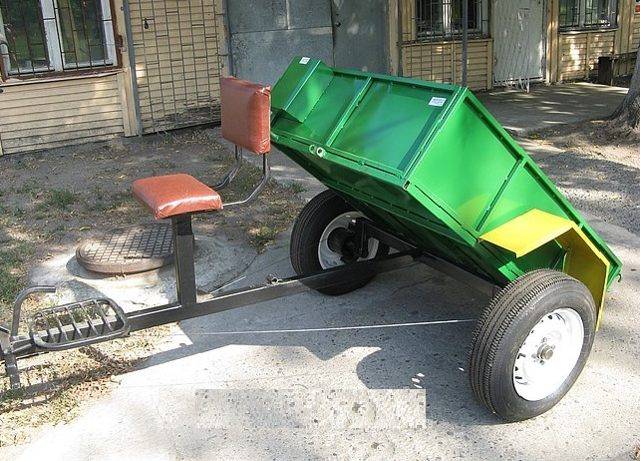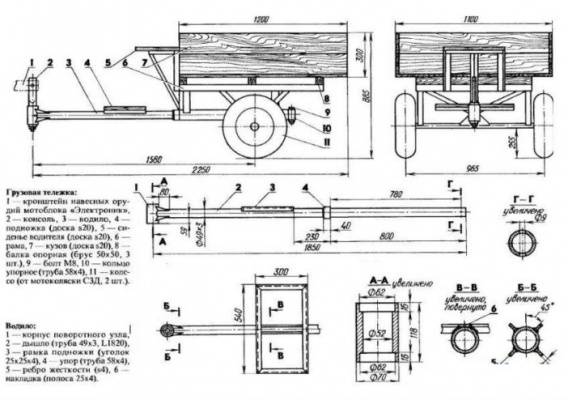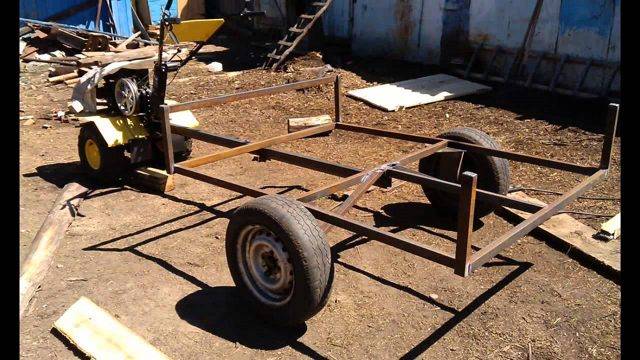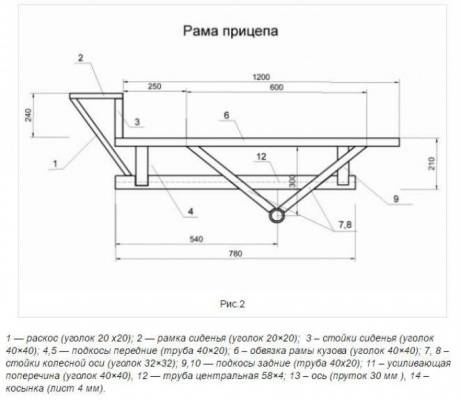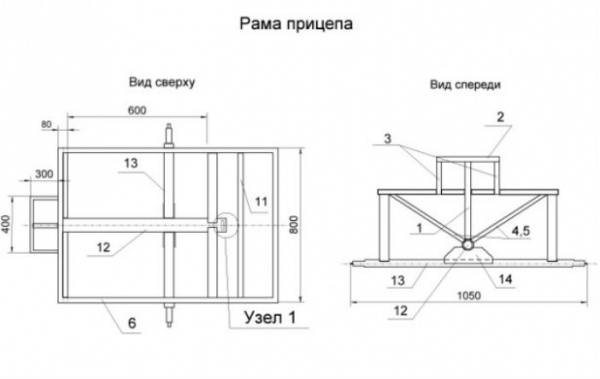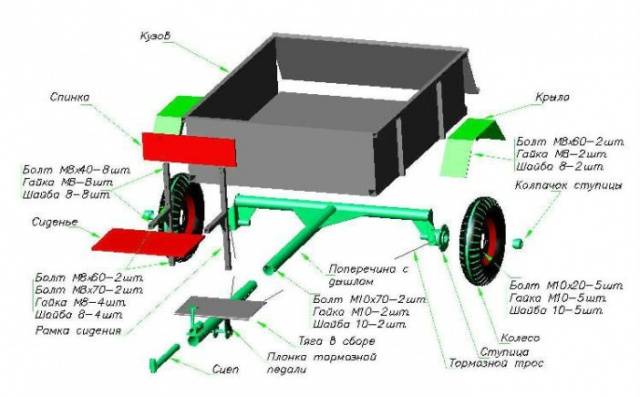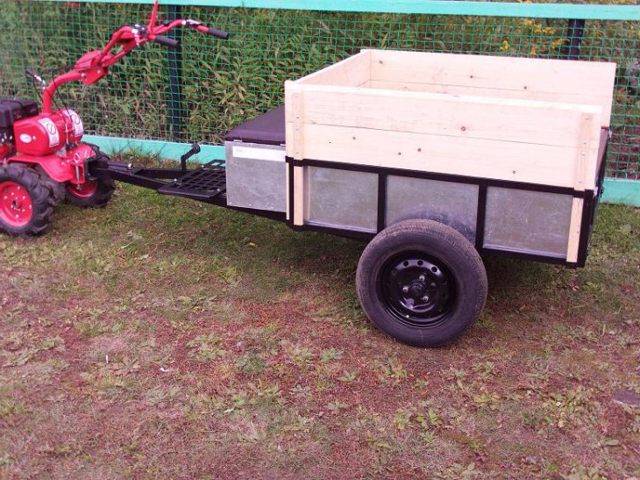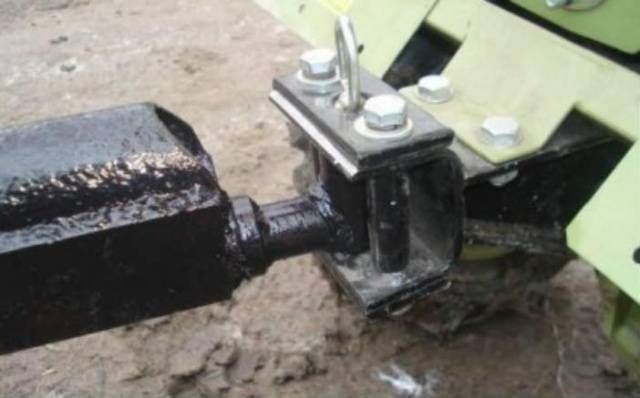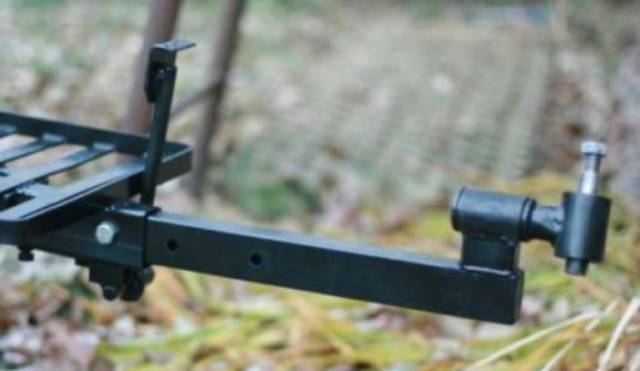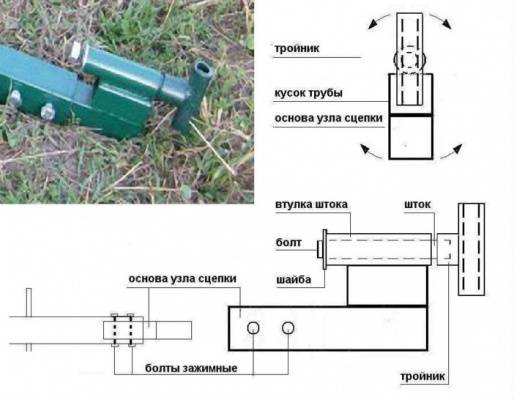Content
If you intend to carry out the transportation of goods by a walk-behind tractor, then you cannot do without a trailer. Manufacturers offer a huge selection of bodies from simple models to dump trucks. However, their cost is quite high. With the ability to perform welding work, a trailer for DIY walk-behind tractor it will turn out to be done with minimal cost.
Varieties of trailers
The walk-behind tractor is a technique with limited tractive power. You cannot mindlessly attach any trailer to it and load it as much as the height of the sides of the body allows. First of all, the choice of a trailer for a walk-behind tractor is carried out in terms of size and carrying capacity:
- Light motoblocks are equipped with a motor with a capacity of up to 5 liters. from. For such units, the optimal dimensions of the trailer are: width - 1 m, length - 1.15 m. Maximum carrying capacity - up to 300 kg. The price of such prefabricated trailers ranges from 200 USD. e.
- The middle class of motoblocks is most in demand by private traders. This technique is already powered by a motor with a capacity of more than 5 liters. from. Trailers with a width of 1 m and a length of up to 1.5 m are suitable here. In the store, their cost ranges from 250 USD. e.
- Professional motoblocks of heavy class are equipped with motors with a capacity of 8 horsepower. The equipment is capable of handling a trailer with a width of 1.2 m, and a length of 2 to 3 m. For such dimensions, a solid support is required, which is explained by the presence of two axles. The price of prefabricated trailers starts at $ 500. e. During the transportation of goods, it is impossible to "squeeze" everything that it can from the walk-behind tractor. From a strong overload, the engine overheats, accompanied by rapid wear of the working parts.
The choice of trailers according to the type of design more affects the comfort of use:
- The cheapest to buy and easiest to manufacture are models with a solid body. The sides are permanently fixed to the bottom and cannot be opened during unloading.
- The best option in terms of price / ease of manufacture is a trailer with drop sides. Moreover, on the body, it can only open one rear or together with the side ones. Such models are very convenient when transporting bulky goods, the main thing is that their weight does not exceed the permissible norm.
- Dump trucks are more expensive and more difficult to manufacture, but they are convenient for unloading bulk cargo.
Knowing what trailers are, you can think about a more suitable option for yourself.
Features of the design of trailers associated with their carrying capacity
Before buying a trailer, you need to take into account that it is attached to the walk-behind tractor with a drawbar using a special towing device. Prefabricated units have a coupling mechanism. On a homemade product trailed to a walk-behind tractor, you will have to make it yourself.
Even when choosing a model, you need to take into account the design features associated with the carrying capacity:
- Dump trucks designed for high carrying capacity are always produced with two axles, plus they are equipped with hydraulics.
- Single-axle dump trucks designed for low payloads have manual body tipping. To do this, it is placed on a frame with an offset of the center of gravity.
- Any type of trailer designed for a lifting capacity of more than 350 kg is equipped with a mechanical brake.While driving with a large load, it will not be possible to stop the walk-behind tractor only with its own brake.
After familiarizing yourself with all the nuances of the device, you can go to the store or start making your trailer.
Self-production of a trailer for a walk-behind tractor
For craftsmen and technology lovers, we suggest that you familiarize yourself with the guide on how to make a trailer for a walk-behind tractor from materials available on the farm. Let's take a uniaxial model as an example.
Development of drawings
During the manufacture of a trailer for a walk-behind tractor, drawings will definitely be needed. They can be found ready-made. The photo shows a diagram with the dimensions of a single axle trailer. You can take it as a reference or look for other drawings on the Internet, and then modify them.
The diagram should show all the nodes of the structure, as well as the methods of fastening the elements. It's good when you know how to draw drawings yourself. Then it will turn out to make just such a trailer with which it will be comfortable to work.
Frame and body manufacturing
The frame is the basis of trailers for motoblocks. The wheelset and the body itself are attached to it. Only metal is taken for its manufacture. The frame is assembled in the following order:
- The frame lattice itself is welded from a profile pipe with a section of 60x30 mm. To give it rigidity, at least five crossbars are welded on.
- At the corners of the rectangular lattice, racks are welded from pieces of pipe. The sides will be attached to them.
- Below, under the grill, two stands for the wheel axle and the drawbar are welded.
- The frames of the boards are welded from a corner with a section of 25x25 mm. Their further attachment to the racks on the grille depends on the selected body type. The frames of the opening sides are attached with hinges, and the stationary ones are simply welded to the posts and lattice elements.
As a result, you should have a frame as shown in the drawing provided.
Wheelset installation
From the bottom of the frame, two racks for the wheelset were welded. Now you need to fix the axis to them. It can be removed ready-made from a car or made on your own. The second option will require hubs, bearings, wheels with disks. It is better to make the axle itself from a steel rod with a minimum diameter of 30 mm. The principle of wheelset assembly can be seen in the photo.
Body trim
When the skeleton of the trailer is already on the wheels, you can begin to sheathe the body. The choice of material for these works is small. Only two options are suitable: boards or sheet metal. As for the wood, such a body will not be durable. Boards from dampness can be protected by impregnation and painting, but during loading and unloading operations, the possibility of their damage is not excluded.
The best option is sheet steel. For the manufacture of the bottom of the body, metal with a thickness of at least 3 mm is required. The sides can be sheathed with iron from 1 mm thick. Some craftsmen have adapted corrugated board for these purposes.
The combined body will turn out to be quite good. For the bottom, sheet steel is still taken, and the sides are sheathed with a 15 mm thick board. There is even an option for making removable patches. With four boards made of boards, you can quickly build up the sides when you need to transport a light, but oversized cargo in a trailer.
The video shows an example of making a dump trailer for a walk-behind tractor:
Manufacturing of a hitch
So, in our design, only the drawbar is not finished yet. It is necessary to organize a node that will couple the walk-behind tractor with a trailer. Each factory-made unit has a special unit for installing a plow and other attachments. A trailer is connected here. There is no such unit on homemade products, therefore, you will have to deal with the manufacture of a trailing device for a walk-behind tractor yourself.
The photo shows an example of hitching a trailer drawbar with a standard shackle hitch. The two elements are fixed with a steel pin. A similar bracket can be put on a homemade walk-behind tractor. Then it will be possible to install a plow, harrow and other factory-made equipment.
The next version of the hitch is represented by a movable joint. The tee of the trailing mechanism is fixed at one end inside the sleeve on bearings. The structure is welded to the drawbar, and is connected to the walk-behind tractor with the same steel pin.
This swivel hitch will not work with the plow and most other attachments, but the trailer will adapt perfectly on uneven roads. The drawbar will rotate due to the bearings, which will relieve the hitch from deformation.
The video shows a version of the coupling for the MTZ walk-behind tractor:
Conclusion
This completes almost all the work on assembling the trailer. It remains only to equip the driver's seat. It is attached to the drawbar or placed in the body. It all depends on the length of the hitch, because it is necessary that the operator of the walk-behind tractor has convenient access to the control levers.
